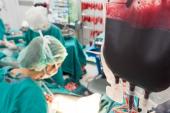AHA: More Screening Needed to Catch Myocardial Injury After Noncardiac Surgery
Troponins should be monitored for up to 3 days postsurgery, the scientific statement says.

With up to 20% of patients having elevated troponin levels following noncardiac surgery, most of whom have no symptoms, a new American Heart Association scientific statement recommends screening for at least 2 days in patients at moderate-to-high risk of myocardial injury after noncardiac surgery (MINS).
First coined in 2014, MINS has been linked with increased mortality, yet many cases are missed. It is thought to be triggered by sedation, anesthesia, or analgesics given postsurgery, and the condition is more likely to be seen in patients with a greater burden of cardiovascular risk factors, including those older than 75 years and patients with sleep apnea, anemia, congestive heart failure, diabetes, and hypertension.
“The main message of this is that MINS is common, it's silent, and it's deadly, so we have to take it seriously,” Kurt Ruetzler, MD, PhD (Cleveland Clinic, OH), who served as chair of the writing committee, told TCTMD.
While some institutions may check for troponins already, “in the past, unfortunately, many physicians just ignored it,” he continued. “They would say, ‘It's just a lab value, so who cares? The patient is doing fine.’ But we have to care. We clearly indicate that this patient now is at high risk to die within 30 days after surgery. So this is the major important thing.”
Their statement, published today ahead of print in Circulation, outlines the current available evidence showing that patients with MINS are at four times higher risk of death at 30 days and about 90% of them have no identifiable symptoms. MINS is up to three times more likely in patients undergoing emergency surgery as well as more common following vascular operations and general abdominal surgery.
Since MINS generally emerges within 2 days, the statement advocates for serial troponin testing for the first 48 to 72 hours in patients at moderate-to-high risk. The writing committee advises using statins and aspirin but also anticoagulation with dabigatran to treat MINS.
Firmer Guidelines Still Needed
“Unfortunately, we still lack specific guidelines on how and when to screen for MINS and, if MINS is diagnosed, how and when to intervene,” Meera D. Kondapaneni, MBBS (MetroHealth Medical Center, Cleveland, OH), who was not involved in the document, told TCMTD. “But this statement overall very nicely summated all the consensus points on this, and it certainly gives a direction. . . . This will increase the awareness, one, for MINS, and, two, it encourages us to look into easily accessible testing avenues like troponin, which is such a simple test.”
The main message of this is that MINS is common, it's silent, and it's deadly, so we have to take it seriously. Kurt Ruetzler
The hesitation to order troponin tests after surgery in the past has come from the notion that there’s not much to do with the findings once in hand, she continued. However, “this post-op troponin elevation can actually be used to further risk stratify these patients and help them reduce their future risk. I think that's something that leads to longer vision: you're not just looking at this admission—this is actually going to help the patient in the long term, knowing that they had MINS and some of the things they can do to reduce the risk.”
Kondapaneni also said a “culture change” is needed in the way MINS has previously been looked at as a surgical complication. “We have to turn the needle in such a way that, rather than looking at it as a post-op or peri-op complication that people can get dinged for sometimes, [we instead] look at it is the patient actually has existing risk and this is just telling that the patient had the risk from before and he's now clinically expressing it,” she said. “It's an opportunity to look for long-term risk restratification and prognostication of these patients.”
Kondapaneni said she would like to see work done in the field of preoperative risk assessment, identifying patients who may be more likely to have MINS and also specific prevention and treatment strategies. “This is the beginning [of] the conversation,” she said.
Yael L. Maxwell is Senior Medical Journalist for TCTMD and Section Editor of TCTMD's Fellows Forum. She served as the inaugural…
Read Full BioSources
Ruetzler K, Smilowitz NR, Berger JS, et al. Diagnosis and management of patients with myocardial injury after noncardiac surgery: a scientific statement from the American Heart Association.
Disclosures
- Ruetzler and Kondapaneni report no relevant conflicts of interest.





Comments